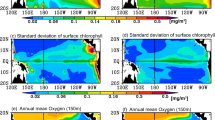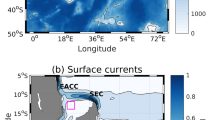Abstract
Western tropical Indian Ocean, Arabian Sea, and the equatorial Pacific are known as regions of intense bio-chemical-physical interactions: the Arabian Sea has the largest phytoplankton bloom with seasonal signal, while the equatorial Pacific bloom is perennial with quasi-permanent upwelling. Here, we studied three dimensional ocean thermodynamics comparing recent ocean observation with ocean general circulation model (OPYC) experiment combined with remotely sensed chlorophyll pigment concentrations from the Coastal Zone Color Scanner (CZCS). Using solar radiation parameterization representing observations that a higher abundance of chlorophyll increases absorption of solar irradiance and heating rate in the upper ocean, we showed that the mixed layer thickness decreases more than they would be under clear water conditions. These changes in the model mixed layer were consistent with Joint Global Ocean Flux Study (JGOFS) observations during the 1994-1995 Arabian Sea experiment and epi-fluorescence microscopy (EFM) on samples collected during Equatorial Pacific Ocean Climate Study (EPOCS) in November, 1988. In the Arabian Sea, as the chlorophyll concentrations peak in October (3 mg/m3) after the summer plankton bloom induced by coastal upwelling, the chlorophyll induced biological heating enhanced the sea surface temperature (SST) by as much as 0.6‡C and sub-layer temperature decreases and sub-layer thickness increases. In the equatorial Pacific, modest concentrations of chlorophyll less than 0.3 mg/m3 is enough to introduce a meridional differential heating, which results in reducing the equatorial mixed layer thickness to more than 20 m. The anomalous meridional tilting of the mixed layer bottom enhances off equatorial westward geostrophic currents. Consequently, the equatorial undercurrent transports more water from west to east. We proposed that these numerical model experiments with use of satellite andin situ ocean observations are consistent under three dimensional ocean circulation theory combined with solar radiation transfer process.
Similar content being viewed by others
References
Chavez P F and R T Barber 1987 An estimate of new production in the equatorial Pacific;Deep Sea Res. 34 129–1243
Chavez F P, Buck K, Barber R T 1990 Phytoplankton taxa in relation to production in the equatorial Pacific;Deep Sea Res. 37 1733–1752
Dickey T, Marra J, Sigurdon D E, Weller R A, Kinkade C S, Zedler S E, Wiggert J D and Langdon C 1998 Seasonal variability of bio-optical and physical properties in the Arabian Sea: October 1994-October 1995;Deep Sea Res., II,45 2001–2025
Feldman G C 1989 Ocean Color: Availability of the Global Data Set;EOS Trans. 70 634
Ivanoff A 1977 Oceanic absorption of solar energy, In:Modelling and Prediction of the Upper Layers of the Ocean, E B Kraus, (New York: Pergamon) 326pp.
Kirk J T O 1988 Solar heating of water bodies as influenced by their inherent optical properties;J. Geophys. Res. 93 10897
Lewis M A, Carr M E, Feldman G C, Esaias W and McClain C 1990 Influence of penetrating solar radiation on the heat budget of the equatorial Pacific Ocean;Nature 347 543–545
Martin P J 1985 Simulation of the mixed layer at OWS November and Papa with several models;J. Geophys. Res. 90 903–916
Morel A and Antoine D 1994 Heating rate within the upper ocean in relation to its bio-optical state;J. Phys. Oceanogr 24 1652–1665
Nakamoto S, Prasanna-Kumar S, Oberhuber J M, Muneyama K, Frouin R 2000 Chlorophyll modulation of sea surface temperature in the Arabian Sea in a mixed layer-isopycnal general circulation model;Geophys. Res. Lett. 27, 747–750
Nakamoto S, Prasanna-Kumar S, Oberhuber J M, Ishizaka J, Muneyama K, Frouin R 2001 Response of the equatorial Pacific to chlorophyll pigment in a mixed layerisopycnal ocean general circulation model;Geophys. Res. Lett. 28, 2021–2024
Oberhuber J M 1993 Simulation of the Atlantic circulation with a coupled sea ice-Mixed Layer-Isopycnal general circulation model. Part I: model description;J. Phys. Oceanogr. 23 808–829
Paulson C A and Simpson J J 1977 Irradiance measurements in the upper ocean;J. Phys. Oceanogr. 7 952–956
Simonot J Y, Dollinger E and Le Treut H 1988 Thermodynamic-Biological-Optical-Coupling in the oceanic mixed layer;J. Geophys. Res. 93 8193–8202
Sathyendranath S, Gouveia A D, Shetye S R and Platt T 1991 Biological controls of surface temperature in the Arabian Sea,Nature 349, 54–56
Author information
Authors and Affiliations
Rights and permissions
About this article
Cite this article
Nakamoto, S., Kumar, S.P., Oberhuber, J.M. et al. Chlorophyll modulation of mixed layer thermodynamics in a mixed-layer isopycnal General Circulation Model — An example from Arabian Sea and equatorial Pacific. J Earth Syst Sci 111, 339–349 (2002). https://doi.org/10.1007/BF02701979
Issue Date:
DOI: https://doi.org/10.1007/BF02701979




